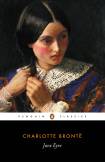Jane Eyre
by Charlotte Brontë
- Discussion Questions
- Internet Resources
- Books by Charlotte Brontë
- Buy this Book!
Enter promo code TEACH for 15% off.
INTRODUCTION
Like Frankenstein and Dracula, Jane Eyre is a Victorian novel that has passed into common consciousness and proved remarkably adaptable, generating several film and stage versions. That Jane Eyre shares this fate with the two greatest horror novels of the nineteenth century is instructive. Like them, it speaks to deep, timeless human urges and fears, using the conventions of Gothic literature to chart the mind's recesses.
The detailed exploration of a strong female character's consciousness has made readers in recent decades consider Jane Eyre as an influential feminist text. The novel works both as the absorbing story of an individual woman's quest and as a narrative of the dilemmas that confront so many women. Its mythic quality is enhanced by the fact that at the time of its writing its author was, like her heroine, unmarried and unremarked, and considered unattractive. In Jane Eyre, Charlotte Brontë created a fully imagined character defined by her strength of will. Though Jane is nothing more than an impoverished governess, she can retort to her haughty employer Rochester: "Do you think, because I am poor, obscure, plain, and little, I am soulless and heartless?—You think wrong!". Jane's willfulness scandalized many contemporary critics, who called her (and the novel) "coarse" and "unfeminine." Such criticisms were powerless against the novel's popularity, and Jane's indomitable voice continues to enthrall readers more than 150 years after the novel's original publication.
In its first-person narration and autobiographical structure, which follows the title character from childhood to adulthood, Jane Eyre has much in common with another durable Victorian novel, David Copperfield. As with Dickens' novel, some of the scenes readers are most likely to remember are those in which the child narrator is nearly overwhelmed by cruelty. Jane Eyre opens with orphaned, ten-year-old Jane's forcible eviction from her window-seat refuge by her vicious and pampered cousin, John Reed. When Mrs. Reed takes John's side and locks Jane in the red-room, the pattern of Jane's oppression by authority figures is set. At Lowood School Jane is singled out for abuse by the tyrannical and self-righteous headmaster, Mr. Brocklehurst. Though apparently powerless—being young, female, poor, and virtually without family—she defies the humiliations Brocklehurst imposes on her. Brontë presents the soft-spoken, forgiving Helen Burns as an example of moral perfection, but it is the outraged and rebellious Jane who is more appealing.
As an adult, Jane faces the romantic prospects of a young woman lacking the social advantages of family, money, and beauty, and therefore especially vulnerable to the allure of admiration and security. By creating two suitors who exemplify opposing threats to Jane's selfhood, Brontë dramatizes Jane's internal struggles against competing temptations, and Jane's efforts to resist both the ascetic St. John Rivers and the sybaritic Rochester provide the most powerful drama in the book. In Jane, Brontë gives us a character able to withstand St. John's missionary call to self-immolation in a marriage to serve humanity and Rochester's attempts to persuade her to indulge her sexual and romantic desires at the expense of her own moral code.
As central to the novel as Jane's conflicted relationship with Rochester is, her connection with his mad, despised first wife, Bertha Mason Rochester, is at least as intriguing, though the two women hardly meet and never converse. The revelation of Bertha's existence, which Rochester has concealed from Jane, saves her from the bigamous marriage that Rochester had planned. Though Brontë's characterization of Bertha, locked away on a top floor, plays into many nineteenth-century stereotypes of the "native" or "primitive" woman, it also suggests a close kinship between Bertha and Jane. Both women are attracted to Rochester; both live in his house; and both are mistreated by him. Critics and readers alike have puzzled over how to understand this connection. To what extent is Bertha a double for Jane, acting on her behalf? To what extent is she a figure for the fate—inarticulate, imprisoned, hopeless—that awaits Jane if she surrenders to the corrupt Rochester?
A similar ambiguity pervades the novel's ending. While Jane's "Reader, I married him" carries a note of relief and triumph, the path to this ending is so convoluted and disturbing as to raise questions about how we are to understand it. If Jane and Rochester's marriage as equals requires not only Rochester's moral regeneration, blinding, and partial crippling, but also Jane's inheriting a small fortune, what is the novel saying about the real-life prospects of a woman like Jane enjoying such a union? Throughout the novel, Brontë asks how a woman in her society can have passion and integrity, love and independence. Jane Eyre does not so much suggest definitive answers as pose the questions with an urgency and a depth of imagination that challenge readers.
Why does Brontë juxtapose Jane's musings about women's social restraints with the mysterious laugh that Jane attributes to Grace Poole?
Rochester tells Jane, "if you are cast in a different mould to the majority, it is no merit of yours; Nature did it". Are we intended to agree or disagree with this statement?
After Mason's visit to Thornfield, Jane asks herself, "What crime was this, that lived incarnate in this sequestered mansion, and could neither be expelled nor subdued by the owner?". What crime does Bertha represent? Why does Rochester keep her at Thornfield?
Does Rochester ever actually intend to marry Blanche Ingram? If so, when does he change his mind? If not, why does he go to such lengths to make Jane believe he does?
Rochester's disastrous marriage to Bertha was based on passion, while St. John refuses to marry Rosamund because of his passion for her. What is Brontë saying about the role passion should play in marriage?
What does St. John feel for Jane? Why does Jane end her story with his prayer?
Jane asserts her equality to Rochester, and St. John. What does Jane mean by equality, and why is it so important to her?
When Jane first appears at Moor House, Hannah assumes she is a prostitute, but St. John and his sisters do not. What distinguishes the characters who misjudge Jane from those who recognize her true nature?
When Jane hears Rochester's voice calling while he is miles away, she says the phenomenon "is the work of nature". What does she mean by this? What are we intended to conclude about the meaning of this experience?
Brontë populates the novel with many female characters roughly the same age as Jane—Georgiana and Eliza Reed, Helen Burns, Blanche Ingram, Mary and Diana Rivers, and Rosamund Oliver. How do comparisons with these characters shape the reader's understanding of Jane's character?
What is the balance of power between Jane and Rochester when they marry? Does this balance change from the beginning of the marriage to the time ten years later that Jane describes at the end of the novel?
For Further Reflection
In a romantic relationship, does one partner inevitably dominate the other? Should an individual who holds a position of authority be granted the respect of others, regardless of his or her character?





